15 Best Gantt Chart Software Tools for 2025 (Free & Paid)
Timelines get messy fast. One tool holds the calendar, another tracks tasks, and no one sees the full picture.
If you’ve searched for Gantt chart software to fix that, you’re in the right place.
We’ve reviewed the most popular Gantt tools across categories, from free chart makers to full project management platforms, and added their user reviews, use cases, pros, cons, and feature overviews.
Quick Summary: The 15 Best Gantt Chart Software Tools (Free + Paid)
1. Productive – Best for Agencies Who Need Gantt + Budgets + Resourcing
Productive is an all-in-one project management platform that gives teams a Gantt-style timeline alongside budgets, time tracking, and resourcing.
It ranks #1 here because it does so much more than just visualize and manage tasks.
It connects schedules with capacity, resource management, and financials, solving problems most Gantt tools leave out.
By combining project timelines with real delivery data, Productive helps project managers plan confidently, stay on budget, and keep teams aligned without juggling multiple systems.
Try Productive’s Gantt solution
Gantt Features in Productive
Before diving into the details, it helps to understand how Productive’s Gantt-style view fits into daily work: it connects scheduling with resource planning, budgets, and progress so teams see the full picture at once.
- Timeline view – Map projects over time so deadlines and phases are clear at a glance.
- Capacity planning – See team availability directly on the timeline to avoid overbooking.
- Milestones – Add key checkpoints so everyone knows when major deliverables are due.
- Task Dependencies – Link tasks in sequence to prevent blockers and highlight risks.
- Time tracking integration – Compare planned versus actual hours to keep projects realistic and profitable.
Productive also has more advanced features like forecasting, AI capabilities, and a scenario builder.
Solve Timeline Chaos With One Tool
Managing project timelines across calendars, spreadsheets, and endless status check-ins creates confusion and wasted time.
Important details get lost, deadlines slip, and no one sees how work connects across projects.
Productive eliminates that friction by bringing task lists, owners, and workload capacity into shared timelines. Teams schedule faster, avoid overlaps, and adjust plans in minutes (instead of hours), with less risk of missed commitments or duplicate work.
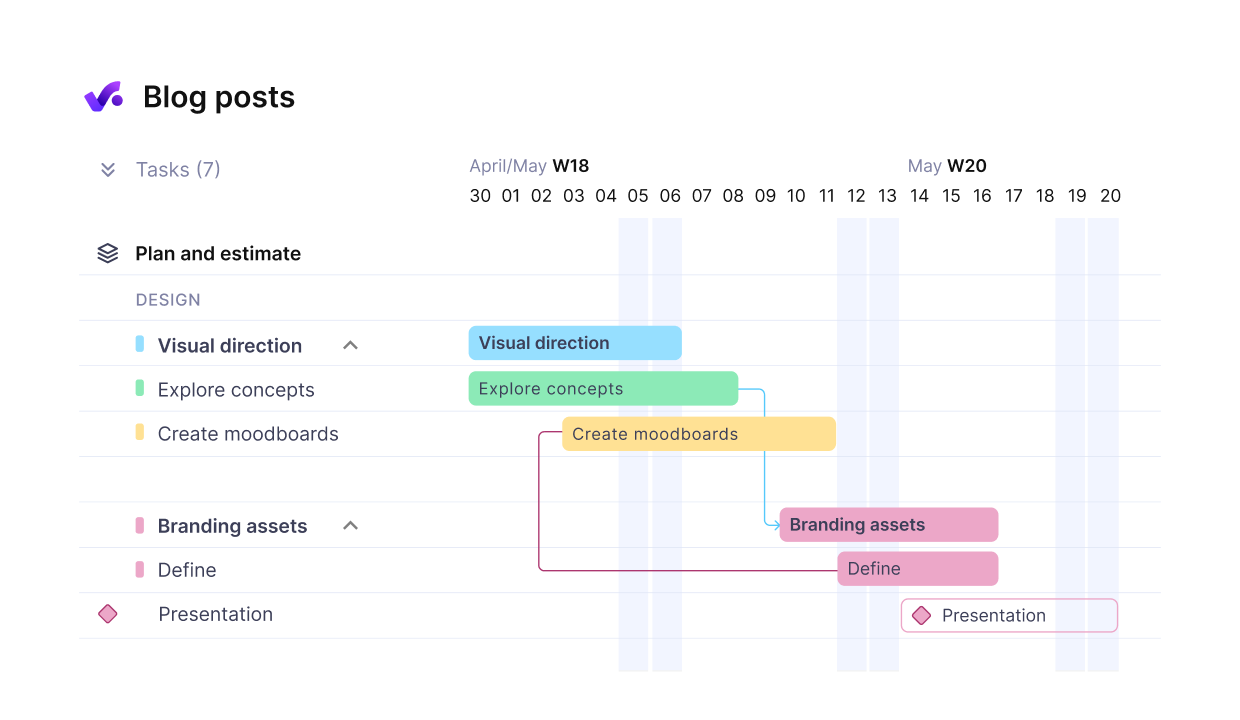
Use Productive for clear work breakdown structures of critical paths and their dependent tasks.
Connect Budgets, Time, and Scope in Real-Time
Most Gantt tools stop at being visual schedulers. Productive is different: it lets you track estimated versus actual time, budget per project phase, and scope creep on the same timeline.
That means managers can see when hours run over, when costs drift, and when changes push delivery off track.
Instead of reacting too late, teams prevent overrun, adjust resources early, and keep clients informed with a chart that shows the full story, not just deadlines.
So yeah, our users have full control over their budgets in one place.
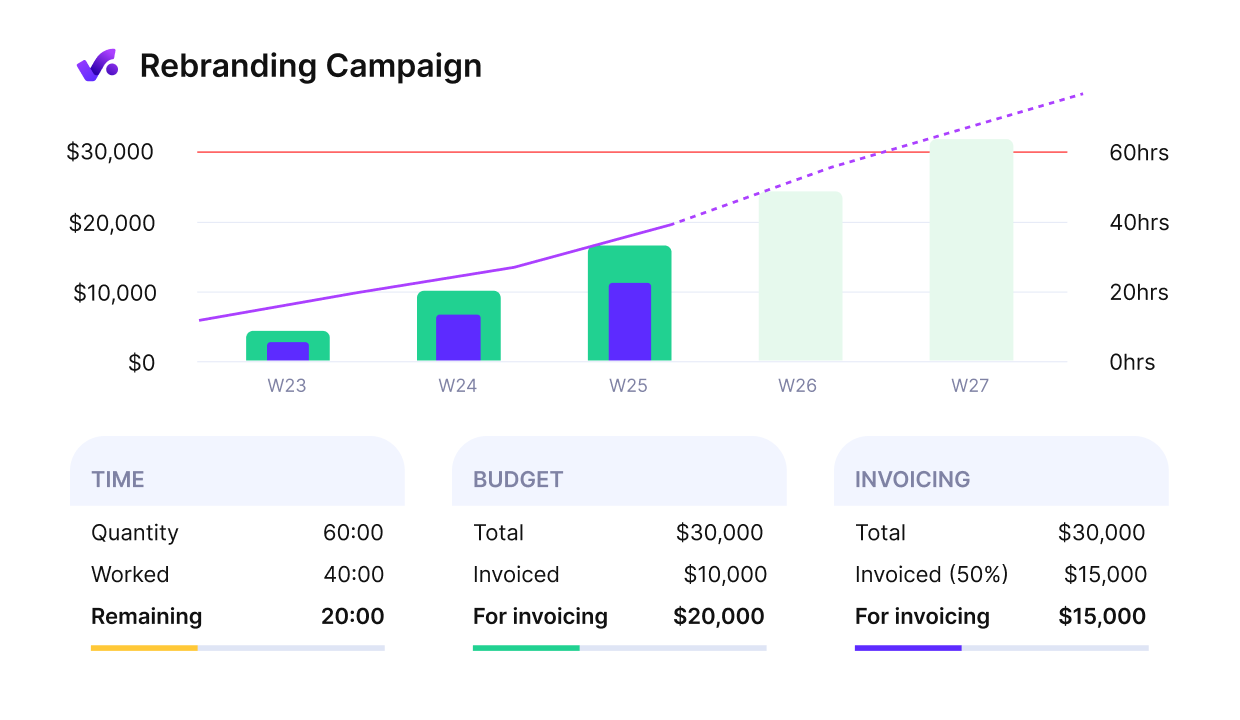
Get an early warning of budget overruns.
Built for Agencies and Professional Service Providers, Not Just Projects
Companies deal with much more than linear projects. They manage multiple clients, shifting scopes, and different billing models all at once.
Productive fits this reality by combining project planning with resourcing, permissions, and client visibility.
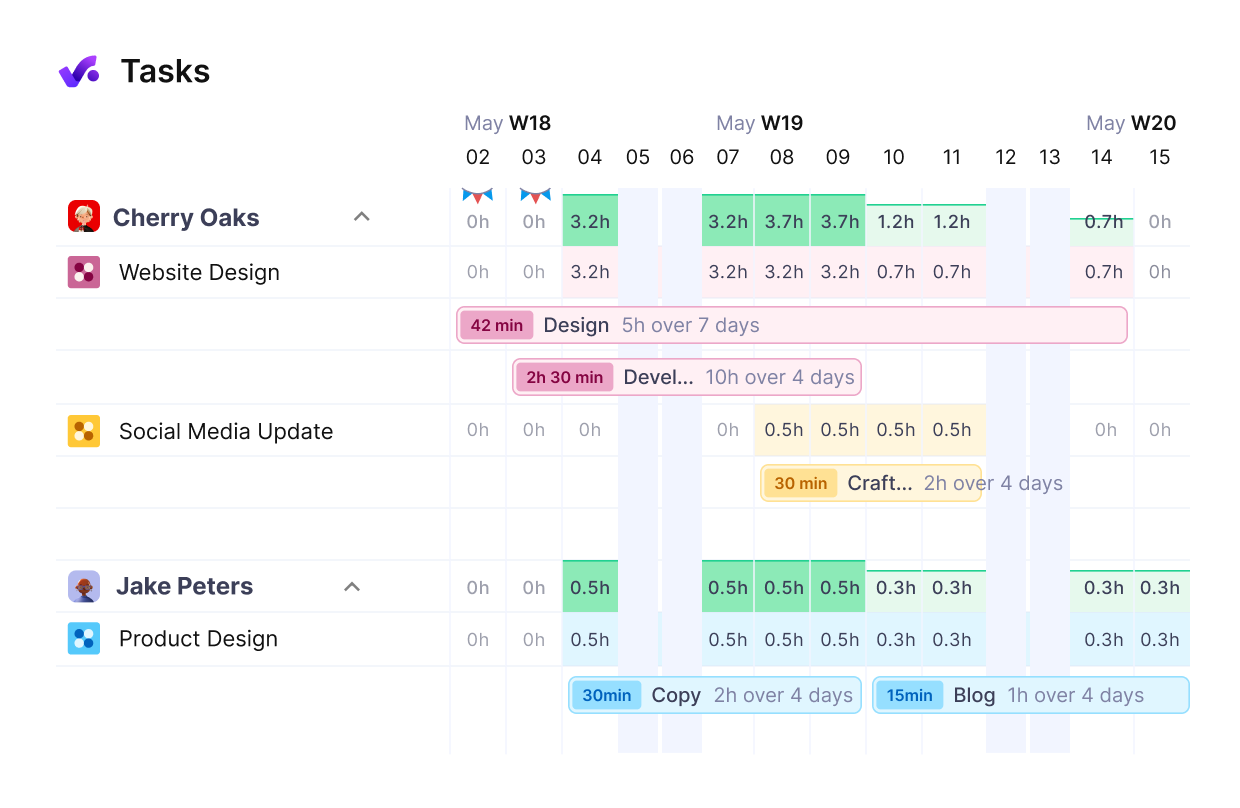
Get a real time overview of your team’s workload.
It’s not just a Gantt app, it’s a complete solution that supports delivery from estimate to invoice. Managers also get detailed reporting with key metrics in real-time.
We’re able to see our schedule out for the next three months easily, and I can put in tasks where I know we have work coming up. That allows me to make sure that I’m not overbooking people or it lets me know where people are overbooked and that I need to get some resources to help us out with the workload. That’s been the biggest shift — at any time Bryan can ask me “Hey, when do we have free time available?” and I can tell him.
Find out how DotDev grew 50% YoY using Productive.
Pricing
- Plans start with the Essential plan at $9 per user per month, which includes essential features such as budgeting, project & task management, docs, time tracking, expense management, reporting, and time off management.
- The Professional plan includes custom fields, recurring budgets, advanced reports, billable time approvals, and many more for $24 per user per month.
- The Ultimate plan has everything that the Essential plan and Professional plan offer, along with the HubSpot integration, advanced forecasting, advanced custom fields, overhead calculations, and more for $32 per user per month.
Productive offers a 14-day free trial, so you can see what it can do for your project’s financial health.
Plan, Track and Manage Projects in Productive
Switch to Productive’s Gantt chart features and get a high-level overview of tasks, milestones, and resources – all in one platform.
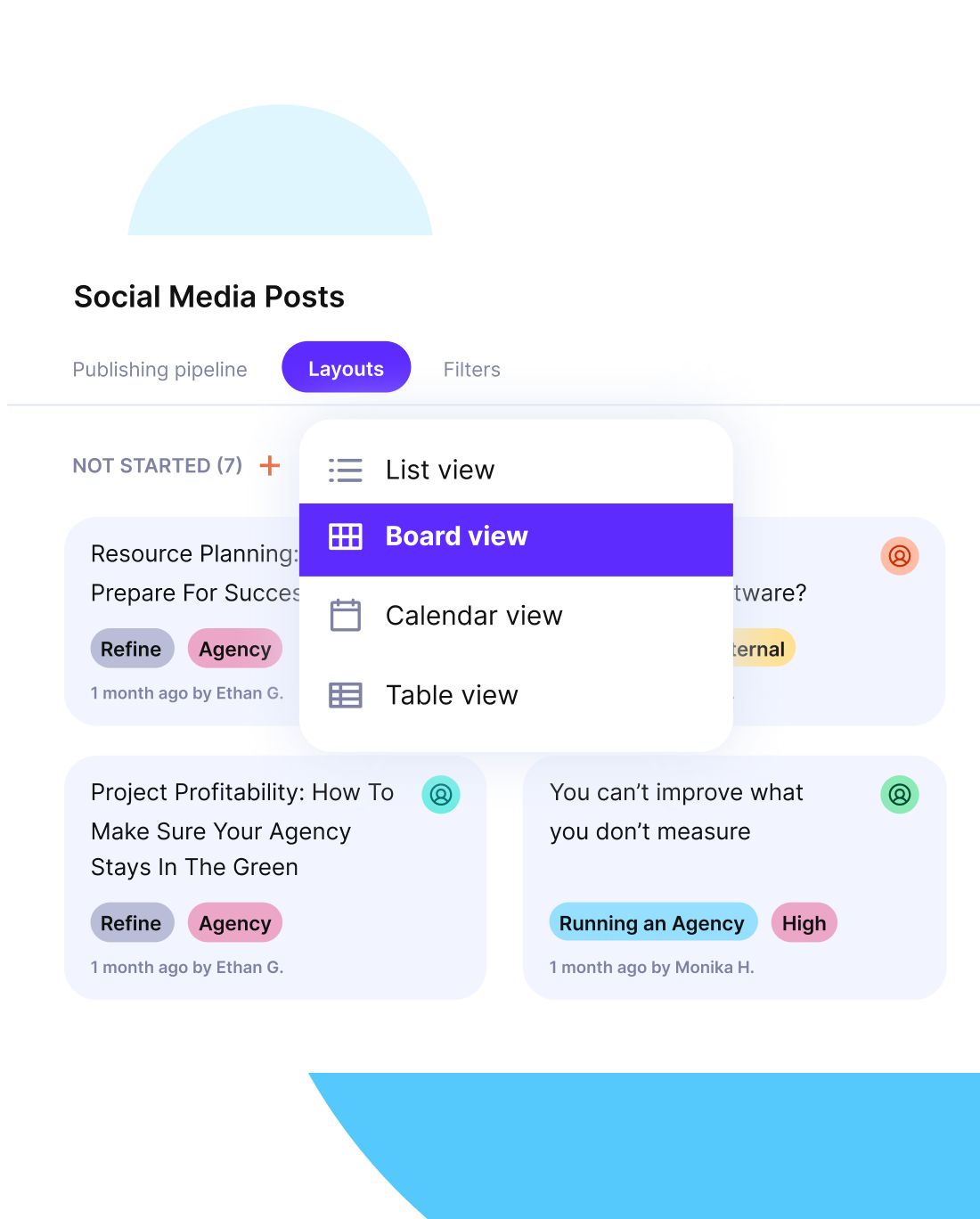
2. TeamGantt – Best for Simple Gantt Views With Friendly UX
TeamGantt is one of the most accessible options for beginners. Its drag-and-drop interface, simple team assignments, and clear visual timelines make it easy to get started.
It’s best suited for small teams, but the free plan is limited, and team collaboration features don’t scale well.
Main Features:
- Drag-and-drop builder
- Task assignments and team scheduling
- Visual clarity for tracking project timelines
- Basic team collaboration and sharing tools
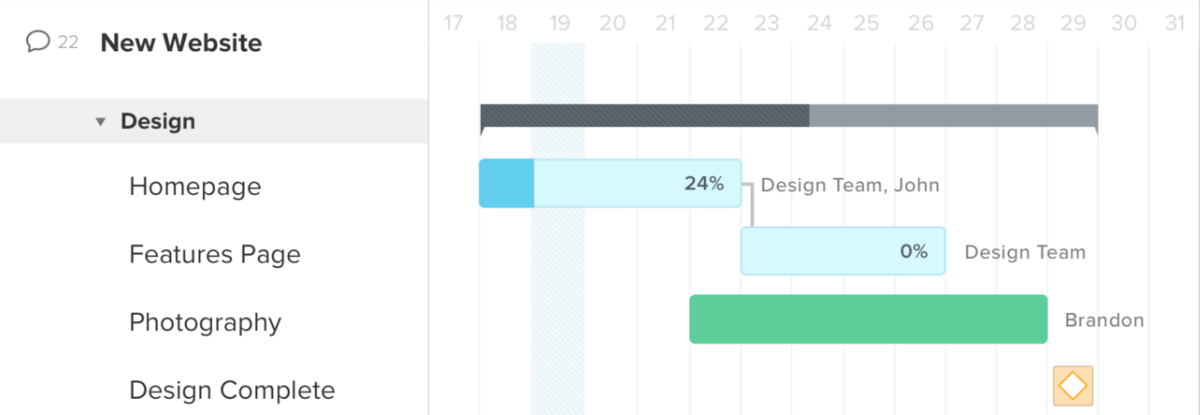
SOurce: TeamGantt
User Feedback:
TeamGantt was great while we had it! We ended up moving to something else with better reporting for our growing team, but TeamGantt’s combination of project management/assignment and resource tracking was great while we were a smaller team.
SOURCE: Capterra Review
TeamGantt is appreciated for its simplicity and usefulness in smaller teams, but users mention that as teams grow its limited features and higher cost make competitors with stronger reporting more appealing.
TeamGantt doesn’t offer you much as I said, so it seems expensive. Its competitors can do what TeamGantt does and offer more features.
SOURCE: Capterra Review
3. GanttPRO – Best for Mid-Sized Teams Who Want Polished Exports
GanttPRO is a clean, efficient Gantt chart maker with standout PDF export capabilities. It’s especially popular with teams that need to present timelines clearly to stakeholders.
While the interface is praised for being intuitive, it does not offer a free version and can feel pricey for smaller teams. Reporting and dashboard customization are also more limited compared to bigger project suites.
Main Features:
- Polished PDF export for professional stakeholder reports
- Clean and intuitive interface
- Task scheduling with dependencies and milestones
- Collaboration tools for assigning and tracking progress
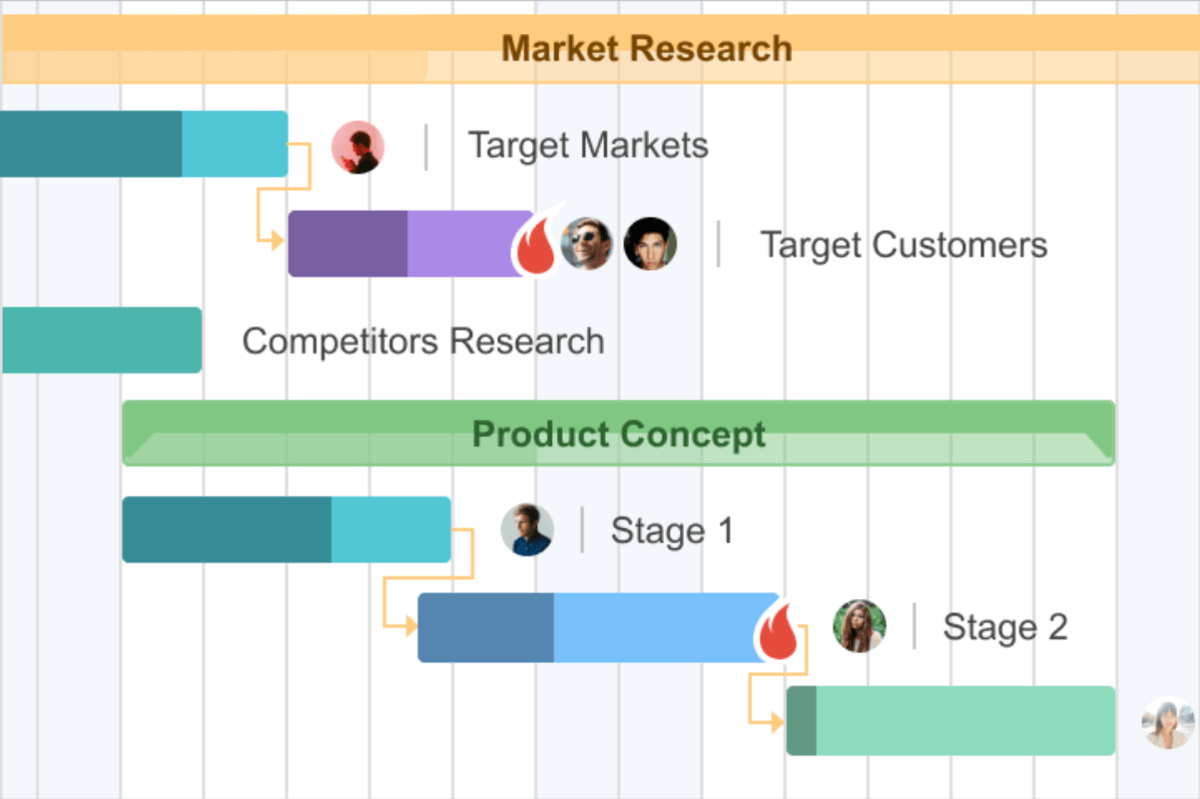
SOurce: ganttpro
User Feedback:
It’s much easier to use than Excel. I have a project that has over 120 line items and it’s almost unmanageable in Excel. I love how easy GanttPRO is to learn and use.
Source: G2 Review
GanttPRO is praised for being easy to learn and far more manageable than Excel for large projects, but users note that complex dependencies can clutter the chart and make task relationships hard to read.
When adding many dependencies the interconnecting lines between dependent tasks jumble together causing the associations between tasks to be unreadable.
Source: G2 Review
4. Instagantt – Best for Asana Users Who Need Gantt Support
Instagantt was built to fill Asana’s Gantt gap. It adds a strong visual builder and direct sync with Asana projects, making timelines easy to understand and share.
While it excels at visuals, limitations include slower performance on large projects, limited date flexibility, and no free tier.
Main Features:
- Visual builder with drag-and-drop tasks
- Two-way Asana integration for live sync
- Task dependencies and milestones built into charts
- Export options for sharing timelines with stakeholders
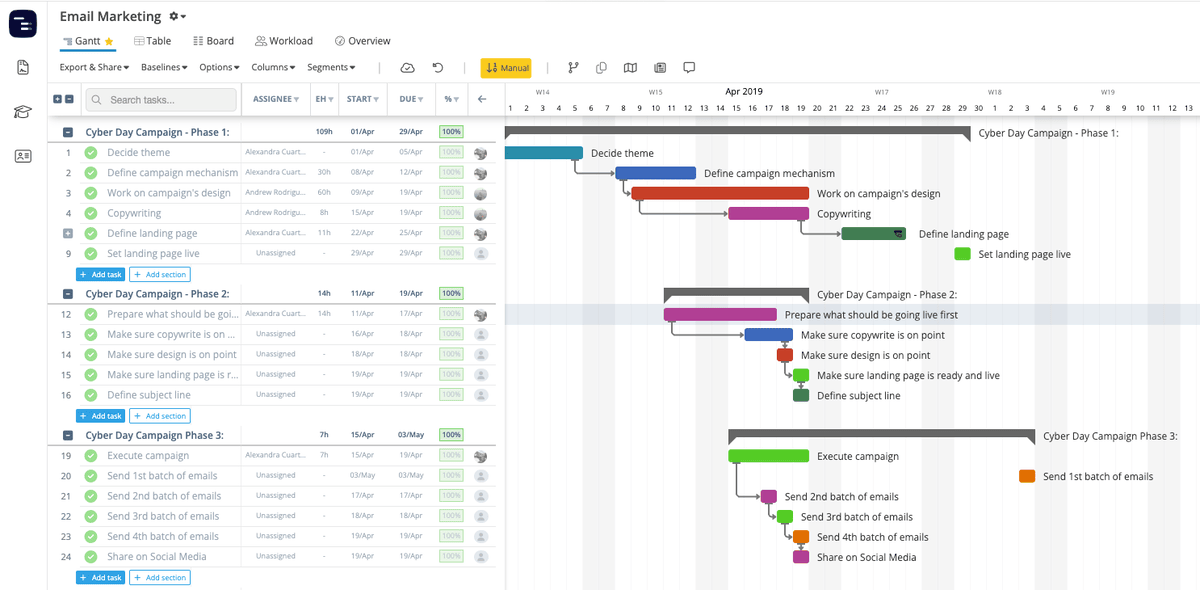
SOurce: Instagantt
User Feedback:
Instagantt is a great application that synchronizes with Asana to graph your projects in Gantt charts or lists. With this totally online software, you register with your Asana account and your projects and tasks are automatically synchronized. Instagantt allows me to follow the daily work of each project assigning the dates and those responsible for each of them.
Source: G2 Reviews
Instagantt is praised for its seamless Asana sync and clear project visualization, though some users feel its limited functionality forces them to adapt their workflows around the tool.
Sometimes I feel that there is some limited functionality, so I need to adjust my business needs for the tool.
Source: G2 Reviews
5. Gantt.io – Best for Creating Presentation-Ready Gantt Charts
Gantt.io is a chart generator designed purely for visuals rather than project management. It’s perfect for building clear charts for proposals, slides, or reports when you need presentation-ready output fast.
There’s a free version that works well for quick visuals, but interactivity and project depth are limited.
Main Features:
- Simple Gantt diagram generator built for speed
- Export visuals for proposals and presentations
- Customizable colors and styles for client-ready charts
- Free version available for lightweight use
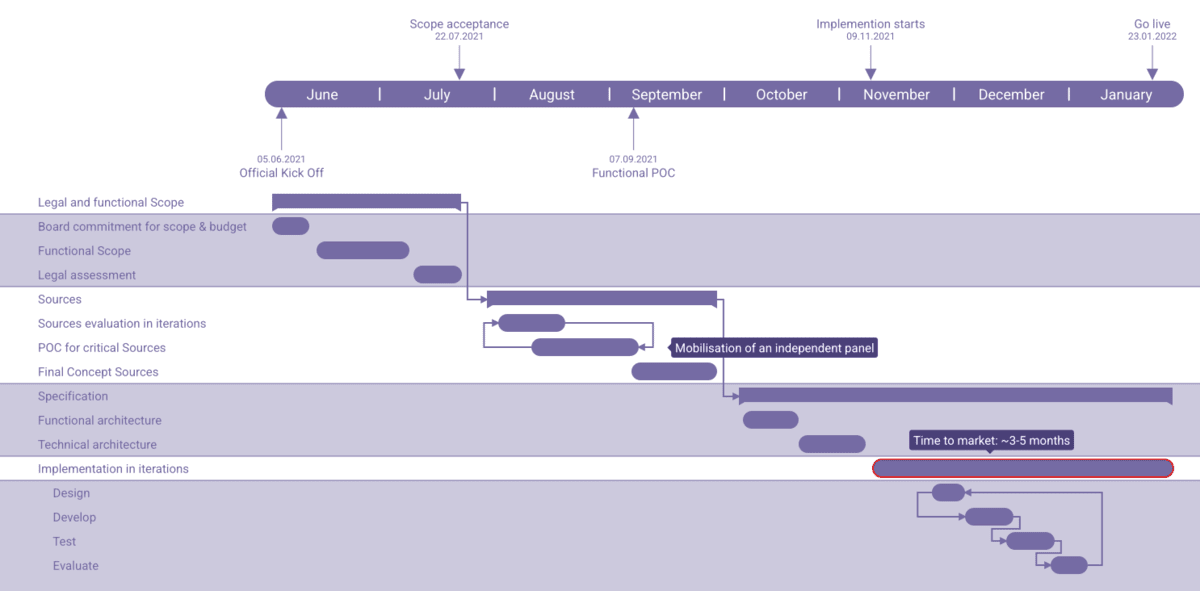
SOurce: gantt.io
User Feedback:
I wish there were reporting features that would allow more resource management capabilities and cost management functions as well. Both of those would help provide the essentials to managing a fair size project.
Source: G2 Review
Gantt.io is appreciated for its quick learning curve and intuitive interface that works well for small projects, but some users miss advanced features like reporting, resource management, and cost tracking for larger project needs.
Great set of tools for simple project planning and management. Quick to learn and intuitive interface. Very useful for managing small projects or personal timelines.
Source: G2 Review
6. Ganttile – Best for Free, Lightweight Gantt Building
Ganttile is a simple, free chart builder that requires no sign-up. It’s best for one-off use or small team plans where you just need to map a timeline quickly.
The tool has no integrations, no collaboration features, and limited editing options, but it’s useful when you want speed over complexity.
Main Features:
- Free chart builder with no registration
- Drag-and-drop task scheduling
- Export charts in multiple formats
- Simple interface designed for quick project planning
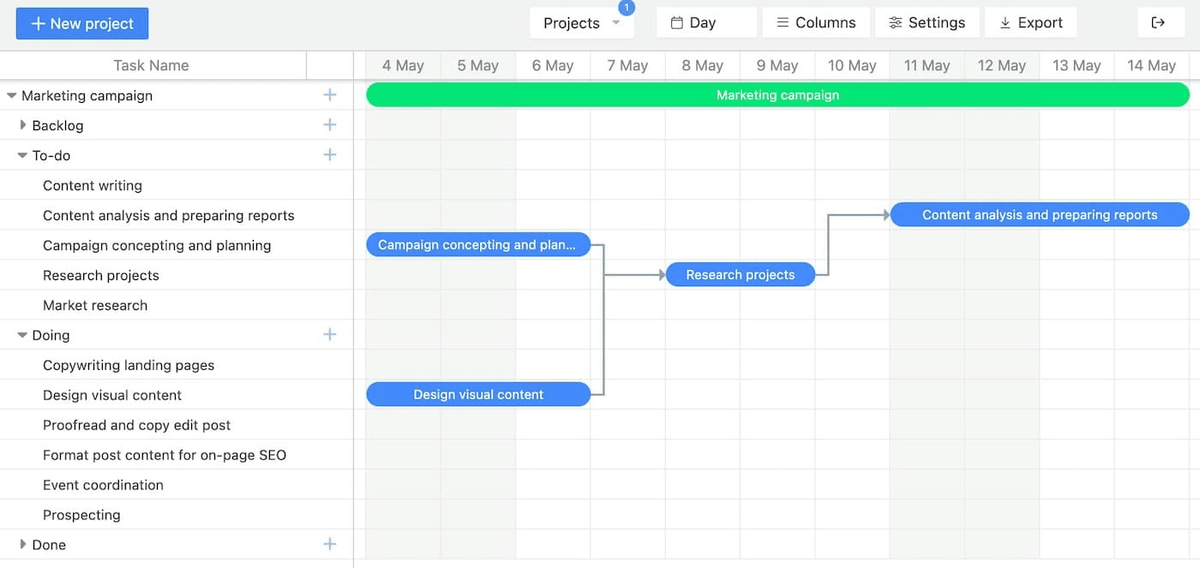
SOurce: Ganttile
User Feedback:
We couldn’t find vetted Ganttile user reviews. However, the tool is a part of the Breeze project management tool. It’s 100% free, and to get started you just need to type in your email address.
If you need an easy-to-use basic chart maker, look no further.
7. Ganttic – Best for Resource Scheduling Across Teams
Gantt is a visual resource scheduler with Gantt chart program functionality that focuses on capacity planning and workload balancing.
It’s particularly useful for teams handling multiple projects at once and wanting to avoid overbooking. The trade-offs are a steeper learning curve and fewer integrations compared to mainstream project management software.
Main Features:
- Resource scheduling across multiple projects
- Gantt-style planning interface with drag-and-drop
- Visual capacity and workload management
- Calendar and timeline views for high-level planning
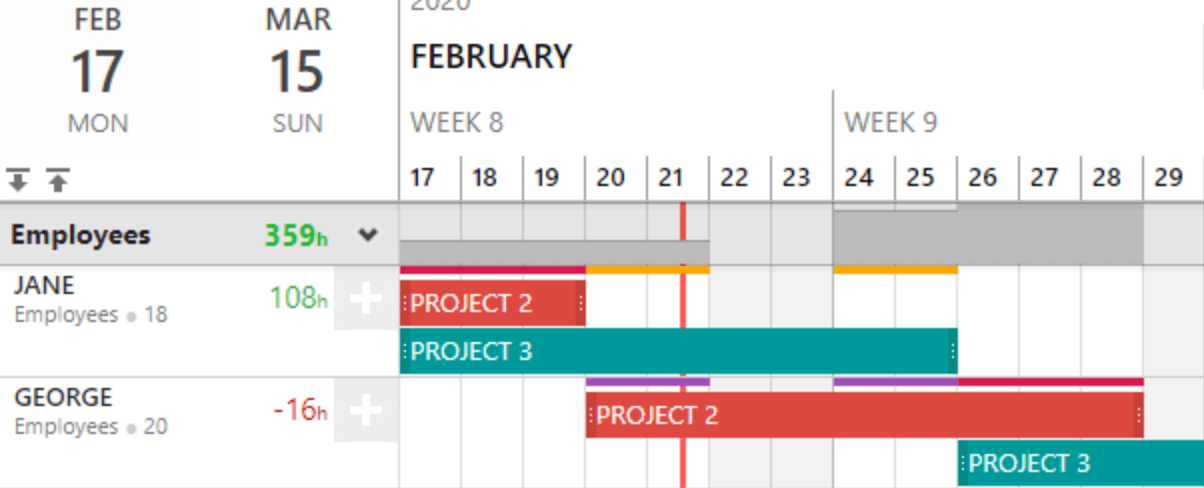
SOurce: Ganttic
User Feedback:
I like best the visual representation of used and unused resource. It’s quick and easy to grasp and analyse and it’s also quick and easy to make necessary changes.
Source: G2 review
Ganttic is praised for its clear visual resource representation and easy adjustments, but users note that with many projects and resources the display can become cluttered and hard to manage effectively.
If you have a lot of projects and resources to manage, like our business, the resulting display is so messy and hard to see it in an organized view that it is not very helpful. You can run reports that help with this somewhat.
Source: G2 review
8. Visor – Best for Dev Teams Syncing With Jira
Visor is a hybrid spreadsheet and Gantt chart tool with real-time Jira sync. It’s ideal for PMs in dev teams who want live project scheduling data in a visual format.
While it’s newer and lacks advanced reporting, it stands out for clarity and strong integration options.
Main Features:
- Spreadsheet-like interface with Gantt chart views
- Real-time sync with Jira for up-to-date project schedules
- Board and timeline modes for flexible planning
- Cloud-based collaboration with sharing options
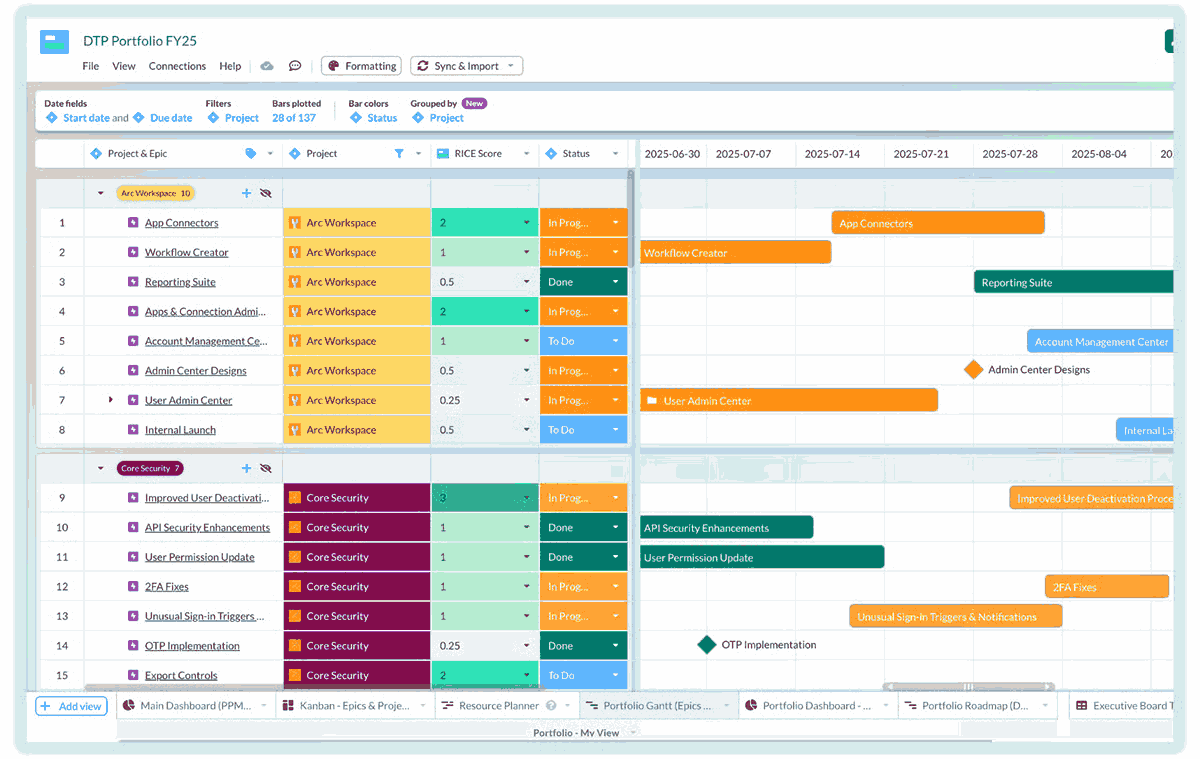
SOurce: visor
User Feedback:
Visor is an incredibly powerful yet simple tool to visualize high level information and most important, to interpret JIRA data. Visor accomplishes this through a simple UI that works very well with JIRA, without creating additional burden.
Source: Capterra Review
Visor is valued for its simple UI and strong Jira integration that makes data easier to interpret, but users point out its high pricing and limited customization keep it from replacing a full spreadsheet solution.
It is actually not a full spreadsheet replacement, with high pricing plan and customization constraints are main constraints
Source: Capterra Review
9. Smartsheet – Best for Spreadsheet Users Who Want Gantt Power
Smartsheet blends spreadsheets with Gantt chart software, offering automation features, dependencies, and templates. It appeals to project managers who love Excel but need more structure.
The trade-offs are a steep learning curve and a weaker mobile UI.
Main Features:
- Spreadsheet-style interface with Gantt views
- Task dependencies and automation options
- Large library of templates for different project types
- Collaboration tools and notifications built in

SOurce: Smartsheet
User Feedback:
The app feels outdated, it is not easy to sort through more recent projects and it feels a bit clunky overall. When I last looked, there was no mac desktop app either which would be nice to have. Some of the project view options are outdated too. So it’s clear updates are being made incrimentally at least.
Source: G2 Review
Smartsheet is appreciated for its straightforward forms and ability to organize information, but users often note that the interface feels dated and clunky, with collaboration and dashboard features needing improvement.
Smartsheet is relatively easy to use once you get the hang of it. The forms are straightforward to build, making it simple to collect and organize information. With better implementation support, improved collaboration features, and more intuitive dashboard/tools, it could be a leader in the space.
Source: G2 review
10. Miro – Best for Collaborative Planning With Gantt-Like Visuals
Miro isn’t a true Gantt tool, but teams often use it to sketch timelines and map project flows. It works well in the early planning phase, where collaboration matters more than structured progress tracking.
The strength lies in shared boards and real-time input, though it lacks the rigor of full project scheduling.
Main Features:
- Gantt-like timeline elements
- Real-time collaboration and commenting
- Templates for project flows and roadmaps
- Integrations with tools like Jira, Slack, and Google Drive
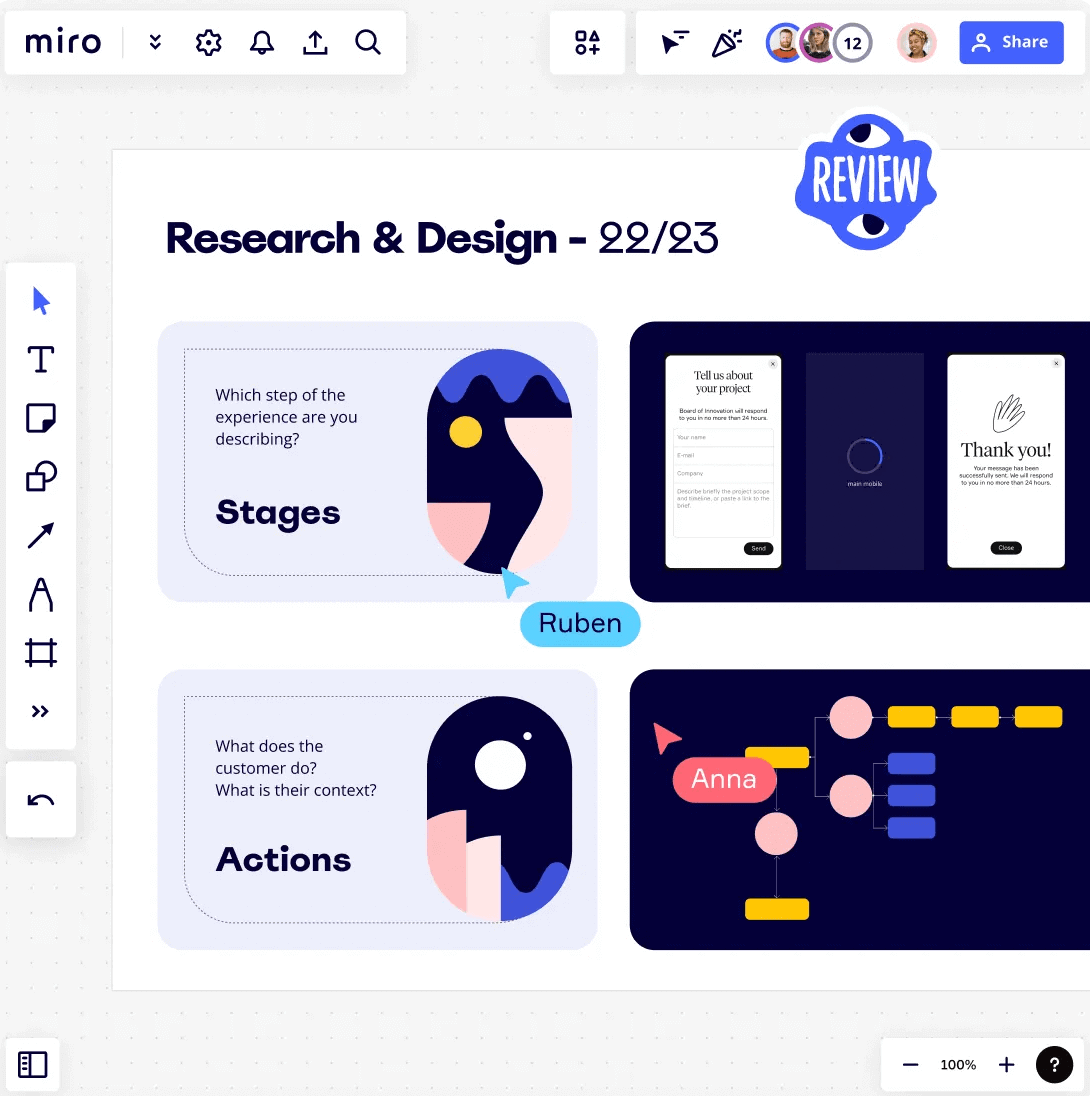
SOurce: Miro
User Feedback:
What I like best about Miro is its ability to bring cross-functional teams together in a truly visual and collaborative way. As a Product Owner, I rely on Miro to map out user journeys, brainstorm features, and align stakeholders – all in real time. The intuitive interface, rich template library, and seamless integrations with tools like Jira and Confluence make it incredibly efficient for agile planning and ideation.
Source: G2 Review
Miro is praised for enabling real-time, visual collaboration across teams with strong templates and integrations, but users criticize its sharing limitations and the high cost of upgrading plans to manage client access securely.
Collaboration with clients is a pain point. On the basic paid plan, Miro allows you to share boards with edit access to the PUBLIC, or anyone with the link. If you want to share edit access of specific boards to specific people (our clients) without making it public to the world, then you have to upgrade your plan and pay DOUBLE for every user on your team. I’m really not happy about that, and it leaves me open to considering other software solutions.
Source: G2 Review
11. Lucidchart – Best for Visualizing Complex Systems and Timelines
Lucidchart is primarily a diagramming tool that includes Gantt chart solution templates. It’s strong for mapping dependencies and complex systems, but weak for live task lists.
Use it when you want clarity and visuals, not day-to-day operations.
Main Features:
- Diagramming platform with Gantt chart templates
- Tools for mapping dependencies, workflows, and critical paths
- Collaboration features for team input
- Customizable diagrams for presentations and reports
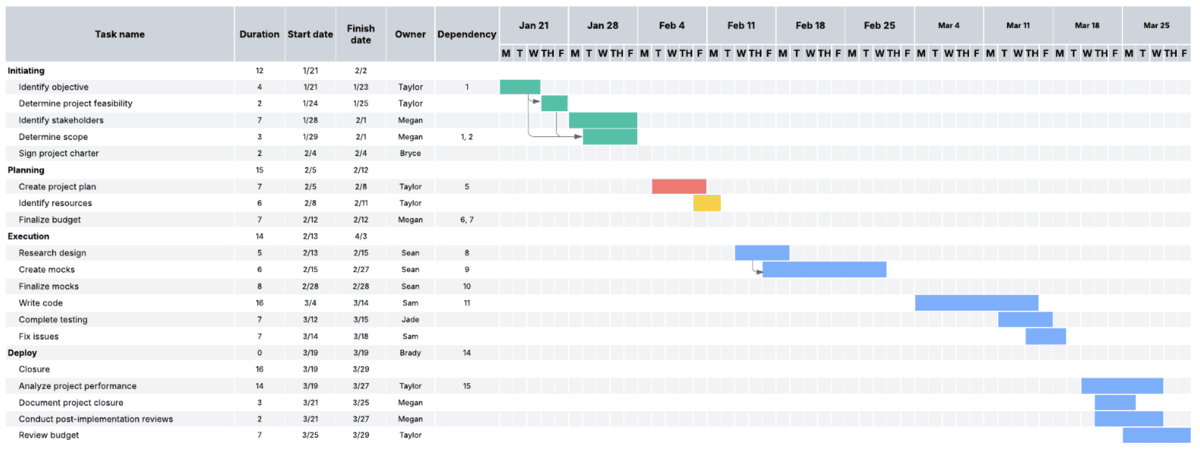
SOurce: Lucidchart
User Feedback:
Great generic-purpose diagramming tools.
It could be even better with some UI tweaks, for example the possibility to add a row or column in between existing rows in a table, dynamic blocks that display text contained in other blocks, a better grid system for the table layout and others.
Source: Trustpilot
Lucidchart is recognized as a versatile diagramming tool with room for UI improvements, but some teams find adoption difficult since creating diagrams can feel time-consuming compared to other work priorities.
Its a useful tool, but the buy-in from our company has not been great. Reps do not like using it as it can take a lot of time to create them. That time would be better spent on sales meetings.
Source: Gartner Review
12. Asana – Best for Teams Already Using Kanban Who Want Timelines
Asana’s project timeline view mimics a Gantt tool but lacks full dependency control unless manually configured. Its strengths are a clean UX and flexible workflow design, but the timeline feature sits behind a paywall.
This makes it better for existing Asana teams upgrading from Kanban-style boards rather than those seeking a dedicated Gantt platform.
For more context, head over to a deep dive on Asana alternatives on our blog.
Main Features:
- Timeline view for visualizing projects over time
- Task dependencies and assignee tracking
- Integration with Asana’s task management workflows
- Collaboration features across teams
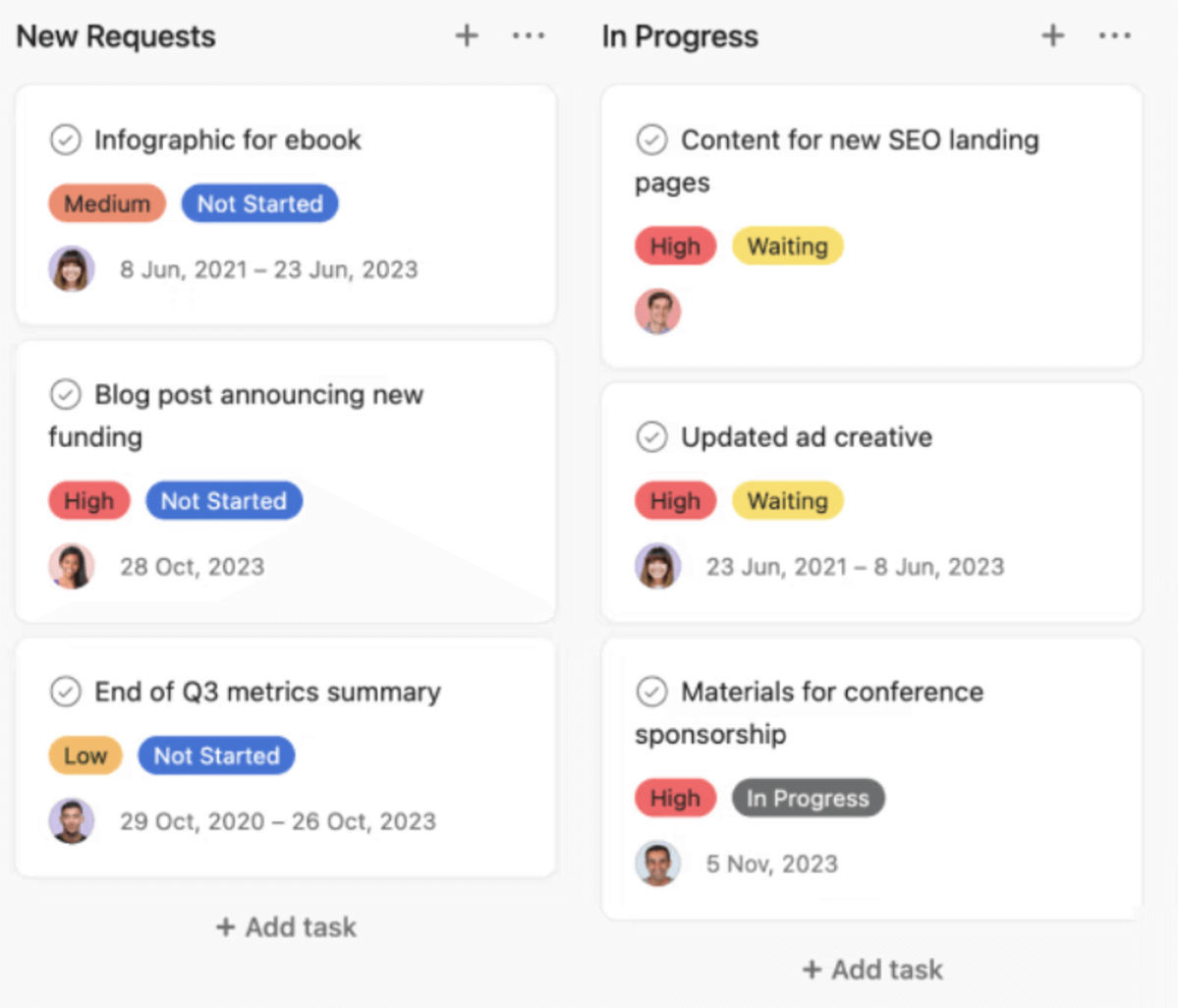
SOurce: Asana
User Feedback:
I’ve used every level of Asana’s products. The free product is fantastic. But with the rise of other free softwares like Notion and Trello I would say their pricing for the paid versions is way more expensive than it should be.
Source: Trustpilot
Asana is valued for its free plan that works well for freelancers and small teams, but users often feel the paid tiers are overpriced compared to alternatives.
I love that Asana is free for small companies like mine. I’m a solo freelancer and don’t need a lot of features.
Source: Trustpilot
13. Airtable – Best for Database-Like PM With Gantt Extensions
Airtable supports Gantt charts through extensions. It’s flexible and powerful, but requires setup. This makes it ideal for teams who want a custom system, though complexity and dependency quirks can be challenging.
Main Features:
- Database-style structure with Gantt extensions
- Highly customizable project views
- Integration options with other apps
- Collaboration across teams in real time

SOurce: Airtable
User Feedback:
When you upgrade from a Team to Business plan, you cannot downgrade without deleting almost your entire base to a free plan. Then you can upgrade back to a Team plan.
Source: Trustpilot
Airtable is praised for its customizable workflows that blend spreadsheet simplicity with database power, though some users warn that plan changes are restrictive and downgrading can be complicated.
What I like best about Airtable is how easy it is to customize and build workflows without needing technical skills. It combines the simplicity of a spreadsheet with the power of a database, making it perfect for project tracking, content planning, and collaboration.
Source: G2 review
14. Toggl Plan – Best for Visual Scheduling and Team Calendar
Toggl Plan offers Gantt app functionality with simple timelines, team calendars, and minimal overhead. Its clean interface makes it a good fit for freelancers or small teams.
The trade-off is limited scalability and missing features like recurring tasks.
Key features:
- Gantt-style timelines for project management
- Shared team calendars for collaboration
- Drag-and-drop project schedules with dependencies
- Simple UI with low learning curve
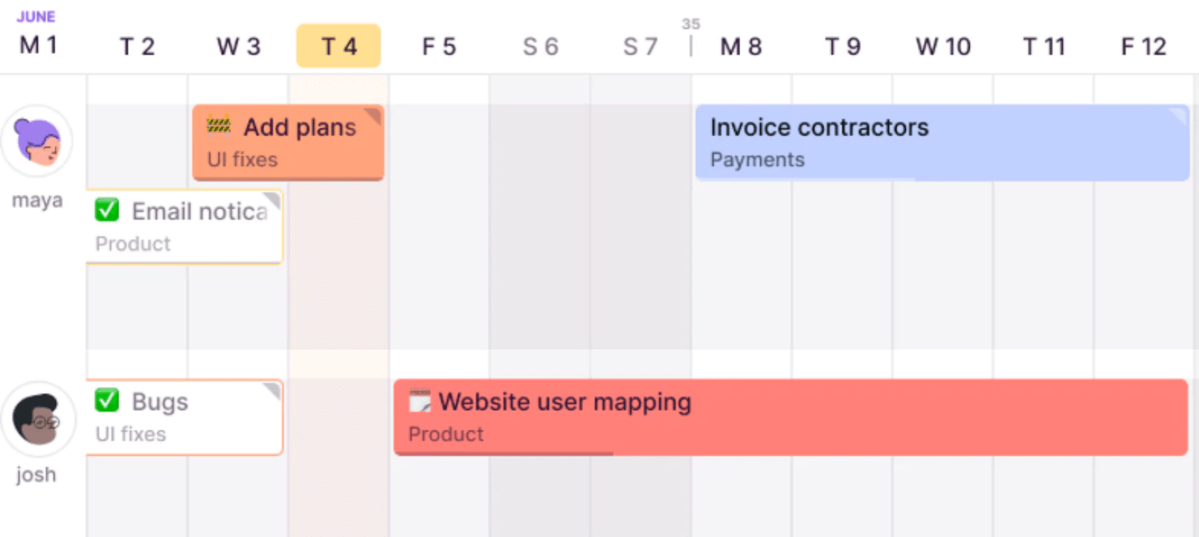
SOurce: Toggl Plan
User Feedback:
Gantt chart interface is bold with colors that pop and grab my attention. I can take a glance at the chart and easily absorb the weekly scheduling. The user functionality is quite intuitive. We basically just click and drag slots during the week.
Source: G2 Review
Users highlight Toggl Plan’s colorful, intuitive Gantt chart interface that makes scheduling simple, but note its limits with complex projects since tasks can’t be assigned to multiple owners or split into sub-jobs.
Toggl Plan does not allow multiple assignments to one job or sub-jobs with separate activities. This can be a drawback for complex projects with shared owners.
Source: G2 Review
15. Paymo – Best for Gantt + Finances
Paymo combines Gantt chart software with time tracking, invoicing, and budgeting in one platform. It works well for agencies that want timelines tied directly to billable hours and client invoicing.
The Gantt view is straightforward for planning, while built-in financials help teams keep delivery and profitability aligned.
Main Features:
- Gantt timelines with dependencies and milestones
- Built-in time tracking connected to projects and tasks
- Invoicing and budget tracking from recorded time
- Resource scheduling and calendar views for capacity planning

SOurce: Paymo
User Feedback:
I dislike how confusing it is and it is difficult to use. Compared to Click-Up, it doesn’t connect tasks well. I’m not sure if even that feature is available because I tried looking for it, but haven’t found it yet. In Click-Up, you could see when the task before your task has been completed or not, which then it would tell you that you can start your task now.
Source: G2 Review
Some Paymo users appreciate its all-in-one approach, but feedback often mentions that the tool feels confusing, lacks smooth task connections, and has limited customization, with costs increasing quickly as teams grow.
A lot of our employees haven’t learned how to use the software properly, making them not want to use it. No custom branding. You also can not customize your dashboard to your preferences. It costs more to add more users to the program instead of a set amount.
Source: G2 Review
What Are the Key Features of Gantt Chart Software?
The key features of Gantt chart software are drag-and-drop timelines, task assignments, milestones, dependencies, visual layers, and resource views. These features let teams schedule logically, track progress, and manage workload in one place.
These features give project managers a way to manage visually while keeping planning tied to real capacity and client delivery. For more know-how, head over to our Gantt chart guide.
Reader’s Checklist of Must-Have Features:
- Drag-and-drop timelines – Move tasks easily to adjust schedules without breaking the plan.
- Task assignments – Show who owns what, so accountability is visible across projects.
- Milestones – Mark major checkpoints so teams and clients know when big deliverables land.
- Dependencies – Link tasks in sequence so work flows in the right order without conflicts.
- Visual layers – Filter by phase, assignee, or status to keep focus on what matters.
- Resource views – See capacity across people and projects to prevent overbooking.
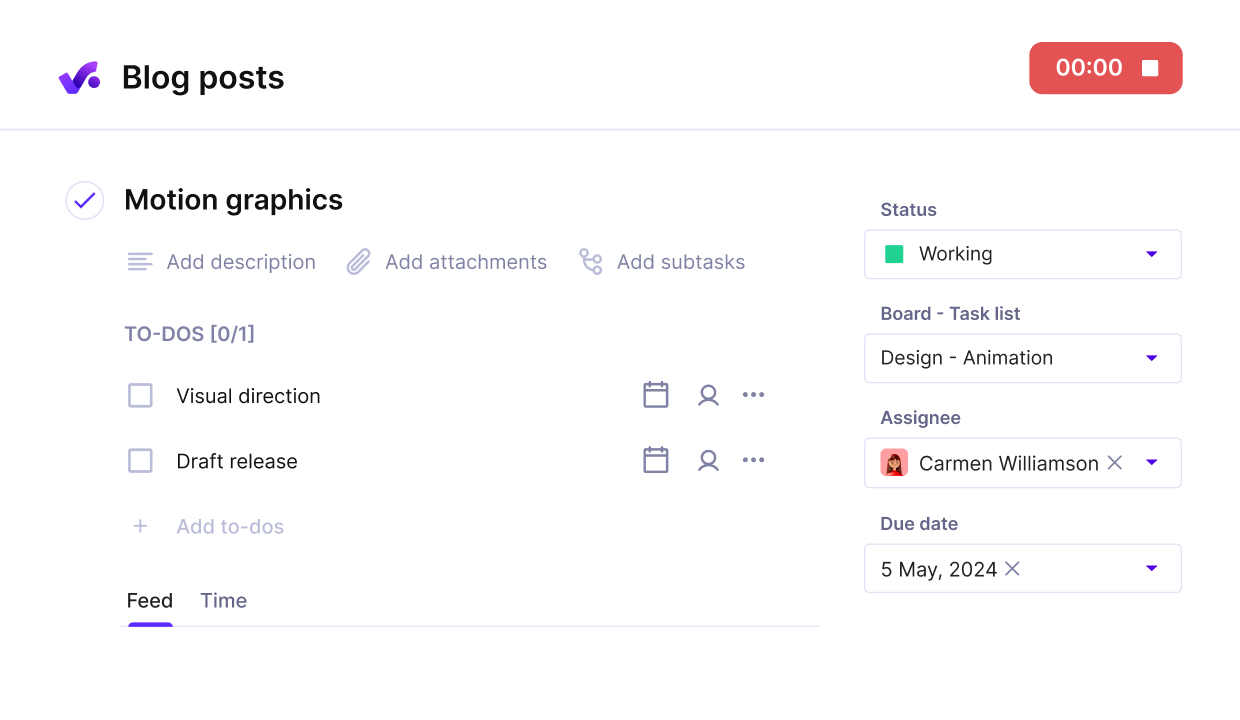
Use Productive to manage tasks with clear owners, descriptions, to-do lists, and dependencies.
How to Choose the Right Gantt Chart Tool?
The way to choose the right Gantt chart tool is by matching its strengths to your team size, workflow type, and top priorities. Let’s break down the top three factors.
Factor 1: Team size
Solo users or startups may prefer free tools like Ganttile or Gantt.io for quick visuals. Mid-sized teams often need polished exports, where GanttPRO stands out.
Agencies managing multiple projects (or clients) benefit from all-in-one platforms like Productive that combine Gantt-style timelines with budgeting and resourcing.
Enterprises may lean toward Smartsheet for scale and integrations.
Factor 2: Workflow type
Structured teams with fixed milestones do well with tools like Productive. Flexible or agile-leaning teams may be better off with Asana or Airtable’s Gantt extensions.
Client-facing agencies often prefer Productive, where charts connect directly to financials. Internal teams who only need visuals can use Miro or Lucidchart.
Factor 3: Priorities
Suppose budget tracking is critical, Productive, or Paymo connects Gantt charts with costs. For resourcing, Ganttic focuses on workload balancing.
For visualization, Gantt.io delivers simple graphics, while for integrations, Smartsheet and Visor are stronger choices.
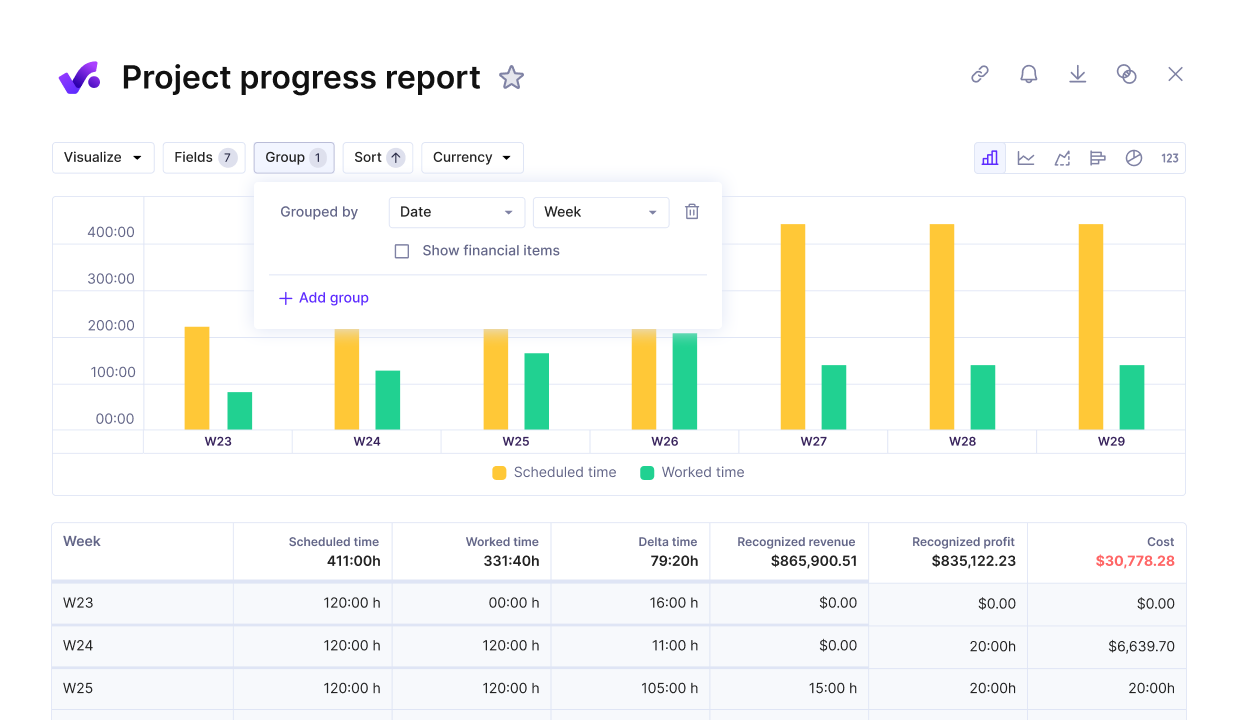
Use Productive to get real-time updates on project progress and costs.
Closing Thoughts on Gantt Apps
Gantt charts remain one of the clearest ways to plan and track projects, but not every tool offers the same strengths.
The right choice depends on whether you need simplicity, visuals, or deeper features like budgeting, resource management, and planning.
If you’re running an agency or service team, a project management platform like Productive gives you more than a chart; it connects timelines with capacity, budgets, and client delivery.
That way, you can keep every project profitable and on track.
Book a demo and learn how to unify timelines, budgets, and resources in one place.
FAQ
What is Gantt chart software?
Gantt chart software is a digital tool that helps teams plan projects on a timeline with tasks, deadlines, and dependencies. It makes complex projects easier to manage by showing who does what and when.
Is there any free Gantt chart tool?
Yes, several free options exist, such as GanttChart and Gantt.io. These are best for quick visuals or small projects, though they often lack advanced features like integrations or resource management.
What’s the difference between Gantt and Kanban?
A Gantt diagram shows tasks over time with dependencies, while Kanban focuses on task flow using columns like “To Do,” “In Progress,” and “Done.” Gantt is better for deadline-driven projects, and Kanban fits teams needing flexibility. For more know-how, head over to our Kanban guide.
Can you use Gantt charts for Agile projects?
You can, but they work best for hybrid teams that want a long-term timeline alongside sprints. Pure Agile teams often find Gantt diagrams too rigid and prefer backlogs or Kanban boards.
What’s the best Gantt chart maker for beginners?
For beginners, tools like TeamGantt or GanttPRO are good starting points. They combine easy-to-use Gantt diagram makers with templates and simple interfaces, helping new users build timelines quickly.
Connect With Agency Peers
Access agency-related Slack channels, exchange business insights, and join in on members-only live sessions.

